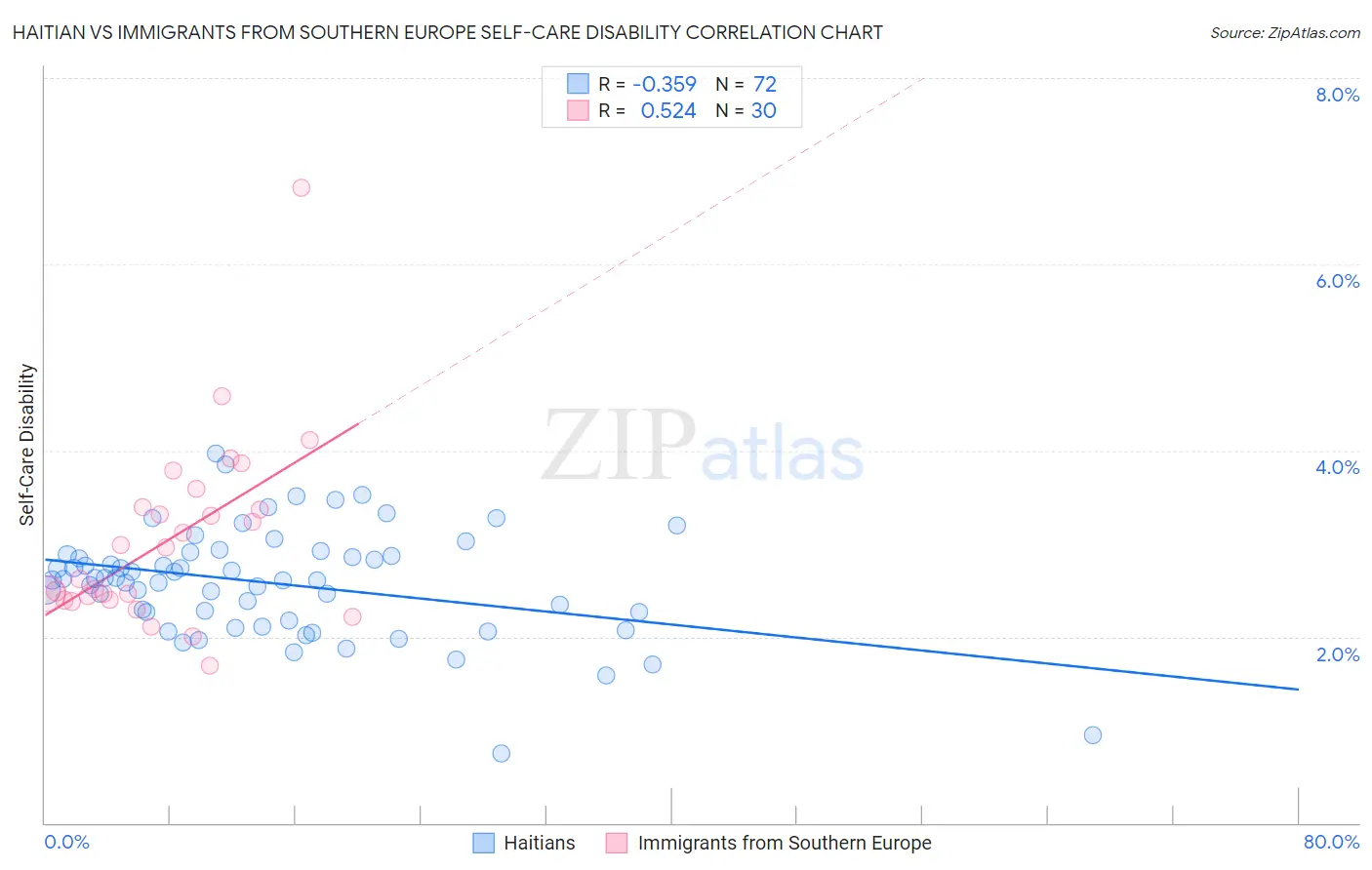Haitian vs Immigrants from Southern Europe Self-Care Disability
COMPARE
Haitian
Immigrants from Southern Europe
Self-Care Disability
Self-Care Disability Comparison
Haitians
Immigrants from Southern Europe
2.6%
SELF-CARE DISABILITY
0.3/ 100
METRIC RATING
254th/ 347
METRIC RANK
2.5%
SELF-CARE DISABILITY
15.6/ 100
METRIC RATING
195th/ 347
METRIC RANK
Haitian vs Immigrants from Southern Europe Self-Care Disability Correlation Chart
The statistical analysis conducted on geographies consisting of 287,578,373 people shows a mild negative correlation between the proportion of Haitians and percentage of population with self-care disability in the United States with a correlation coefficient (R) of -0.359 and weighted average of 2.6%. Similarly, the statistical analysis conducted on geographies consisting of 402,329,644 people shows a substantial positive correlation between the proportion of Immigrants from Southern Europe and percentage of population with self-care disability in the United States with a correlation coefficient (R) of 0.524 and weighted average of 2.5%, a difference of 4.6%.

Self-Care Disability Correlation Summary
| Measurement | Haitian | Immigrants from Southern Europe |
| Minimum | 0.75% | 1.7% |
| Maximum | 4.0% | 6.8% |
| Range | 3.2% | 5.1% |
| Mean | 2.6% | 3.0% |
| Median | 2.6% | 2.8% |
| Interquartile 25% (IQ1) | 2.2% | 2.4% |
| Interquartile 75% (IQ3) | 2.9% | 3.4% |
| Interquartile Range (IQR) | 0.65% | 1.00% |
| Standard Deviation (Sample) | 0.58% | 1.00% |
| Standard Deviation (Population) | 0.58% | 0.98% |
Similar Demographics by Self-Care Disability
Demographics Similar to Haitians by Self-Care Disability
In terms of self-care disability, the demographic groups most similar to Haitians are Immigrants from Haiti (2.6%, a difference of 0.020%), Tsimshian (2.6%, a difference of 0.040%), Immigrants from Central America (2.6%, a difference of 0.060%), Immigrants from Bangladesh (2.6%, a difference of 0.10%), and Immigrants from Liberia (2.6%, a difference of 0.17%).
| Demographics | Rating | Rank | Self-Care Disability |
| Immigrants | Albania | 0.6 /100 | #247 | Tragic 2.6% |
| Nicaraguans | 0.6 /100 | #248 | Tragic 2.6% |
| Mexican American Indians | 0.5 /100 | #249 | Tragic 2.6% |
| Portuguese | 0.4 /100 | #250 | Tragic 2.6% |
| Immigrants | Liberia | 0.4 /100 | #251 | Tragic 2.6% |
| Immigrants | Bangladesh | 0.4 /100 | #252 | Tragic 2.6% |
| Immigrants | Haiti | 0.3 /100 | #253 | Tragic 2.6% |
| Haitians | 0.3 /100 | #254 | Tragic 2.6% |
| Tsimshian | 0.3 /100 | #255 | Tragic 2.6% |
| Immigrants | Central America | 0.3 /100 | #256 | Tragic 2.6% |
| Potawatomi | 0.3 /100 | #257 | Tragic 2.6% |
| Immigrants | Nonimmigrants | 0.3 /100 | #258 | Tragic 2.6% |
| Immigrants | Belarus | 0.2 /100 | #259 | Tragic 2.6% |
| Chippewa | 0.2 /100 | #260 | Tragic 2.6% |
| Arapaho | 0.2 /100 | #261 | Tragic 2.6% |
Demographics Similar to Immigrants from Southern Europe by Self-Care Disability
In terms of self-care disability, the demographic groups most similar to Immigrants from Southern Europe are Korean (2.5%, a difference of 0.010%), Crow (2.5%, a difference of 0.030%), Immigrants (2.5%, a difference of 0.060%), Immigrants from Ghana (2.5%, a difference of 0.080%), and Immigrants from Germany (2.5%, a difference of 0.19%).
| Demographics | Rating | Rank | Self-Care Disability |
| Immigrants | Oceania | 28.3 /100 | #188 | Fair 2.5% |
| Immigrants | Eastern Europe | 28.0 /100 | #189 | Fair 2.5% |
| Sioux | 24.6 /100 | #190 | Fair 2.5% |
| Moroccans | 22.9 /100 | #191 | Fair 2.5% |
| Soviet Union | 22.2 /100 | #192 | Fair 2.5% |
| Ukrainians | 21.4 /100 | #193 | Fair 2.5% |
| Immigrants | Germany | 17.9 /100 | #194 | Poor 2.5% |
| Immigrants | Southern Europe | 15.6 /100 | #195 | Poor 2.5% |
| Koreans | 15.5 /100 | #196 | Poor 2.5% |
| Crow | 15.2 /100 | #197 | Poor 2.5% |
| Immigrants | Immigrants | 15.0 /100 | #198 | Poor 2.5% |
| Immigrants | Ghana | 14.7 /100 | #199 | Poor 2.5% |
| Immigrants | Western Africa | 13.3 /100 | #200 | Poor 2.5% |
| Immigrants | South Eastern Asia | 12.9 /100 | #201 | Poor 2.5% |
| Slovaks | 12.6 /100 | #202 | Poor 2.5% |